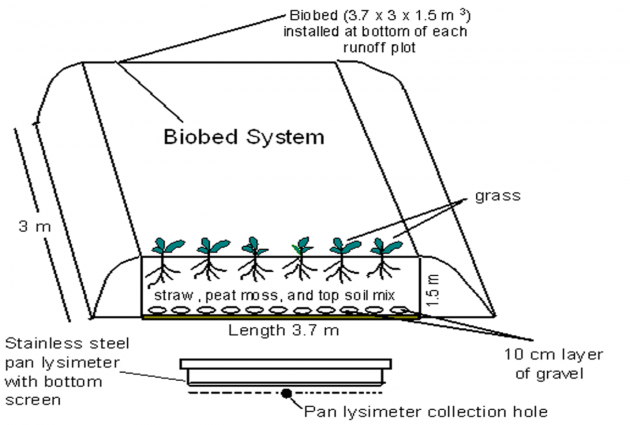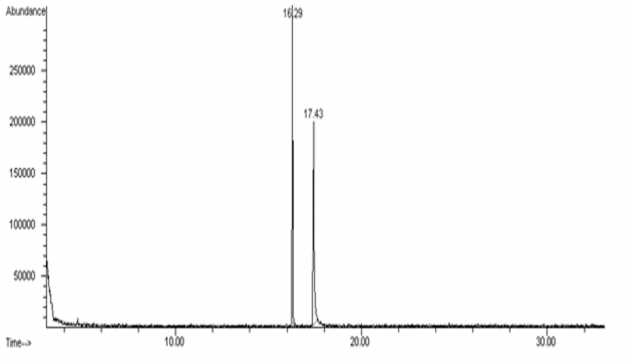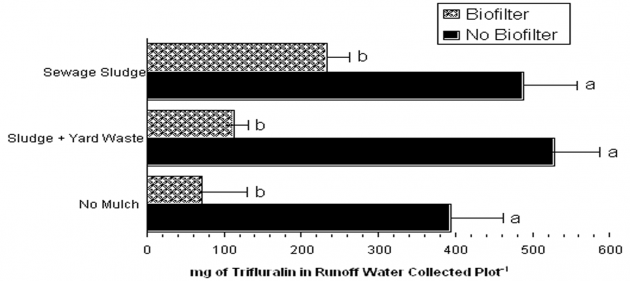![]() Waste to Worth home | More proceedings….
Waste to Worth home | More proceedings….
Abstract
Recycling waste such as municipal sewage sludge (SS) and yard waste (YW) for use as low-cost fertilizer resulted in positive effects on the growth and yield of vegetable crops. Eighteen runoff plots were established at Kentucky State University research farm (Franklin County, KY) to study the impact of soil amendments on reducing surface runoff water contamination by residues of dimethazone and trifluralin herbicides arising from agricultural fields. Three soil management practices: municipal sewage sludge (SS), SS mixed with YW, and no-mulch rototilled bare soil were used to monitor the impact of soil amendments on herbicide residues in soil following natural rainfall events. Biobeds (a soil cavity filled with a mixture of wheat straw, peat moss, and top soil) reduced dimethazone and trifluralin by 84 and 82%, respectively in runoff water that would have been transported down the land slope of agricultural fields and contaminate natural water resources. Biobeds installed in SS and SS+YW treatments reduced dimethazone by 65 and 46% and trifluralin by 52 and 79%, respectively. We concluded that soil amendments could be used to intercept pesticide-contaminated runoff from agricultural fields, creating optimum conditions for sorption and biodegradation such that the amount of pesticides adjacent to water bodies is significantly reduced. This practice might provide a potential solution to pesticide contamination of surface and seepage water from farmlands.
What Did We Do?
Eighteen runoff plots were established at Kentucky State University research farm to study the impact of soil amendments on reducing surface runoff water contamination by residues of dimethazone and trifluralin herbicides arising from agricultural fields.The field trial area was established on a Lowell silty loam soil (pH 6.7, 2% organic matter) of 10% slope located at the Kentucky State University (KSU) Research Farm (Franklin County, KY). The farm is located in the Kentucky River Watershed in the Blue Grass Region. Eighteen (18) field plots of 3.7 m wide and 22 m long each were installed with stainless steel borders along each side to prevent cross contamination between adjacent treatments. A gutter was installed across the lower end of each plot with 5% slope to direct runoff to the tipping buckets and collection bottles for runoff water measurement. At the bottom of each plot, a pan lysimeter (n=18) of 1.5 m deep was installed for collecting infiltration water following natural rainfall events.
At the lower end of each of nine experimental plots, nine biobed systems were installed (Figure 1.). Three soil management practices were used in experimental plots: 1) municipal sewage sludge obtained from Metropolitan Sewer District, Louisville, KY was mixed with yard waste compost (obtained from Con Robinson Company, Lexington, KY) and incorporated into native soil at 15 t acre-1 (on dry weight basis) with a plowing depth of 15 cm, 2) municipal sewage sludge was mixed with native soil at 15 t acre-1 (on dry weight basis) with a plowing depth of 15 cm, and 3) a no-mulch (NM) control treatment (roto-tilled bare soil) was used for comparison purposes. The soil in the experimental area was sprayed with a mixture of dimethazone (Command 3ME) and trifluralin (Treflan) formulations at the recommended rates of application in Kentucky. [1] Seedlings of muskmelon (Cucumis melo cv. Athena) and bell pepper (Capsicum annuum cv. Artistotle) were planted with 25 and 60 cm in-row spacing, respectively. Runoff water under three natural rainfall events was collected and quantified at the lower end of each plot throughout the growing season using tipping-bucket runoff metering apparatus. Pan lysimeters were used to monitor the presence or absence of pesticide residues in the vadose zone, the unsaturated water layer below the plant root. Trifluralin and dimethazone were extracted with 150 mL of a mixture of methylene chloride [CH2Cl2] + acetone (6:1, v/v) using liquid-liquid partition. Concentrated extracts were injected into a gas chromatograph (GC) equipped with flame ionization detector (FID). The gas chromatograph (HP 5890, Hewlett Packard) was equipped with a 30-m (0.23-mm diameter, 0.33-µm film thickness) fused silica capillary column with HP-5 (5% phenyl polysiloxane, 95% methyl polysiloxane) liquid phase. Operating conditions were 230, 250, and 280 °C for injector, oven, and detector, respectively. Under these conditions retention times (Rt) of trifluralin and dimethazone averaged 16.29 and 17.43 min, respectively (Figure 2).
|
|
|
Figure 2. Gas chromatographic (GC) chromatograms of native soil extracts prepared in acetonitrile: hexane: methanol (45:45:10 v/v) at 1 h (upper graph) and 3 d (lower graph) following spraying with a mixture of Clomazone and Treflan formulations at the recommended rate of application |
What Have We Learned?
Herbicide residues detected in soil and water (Figures 3 & 4) were confirmed using gas chromatography (GC)/mass spectrometry (GC/MS) (Hewlett Packard Model 5971a). The increased organic matter content of soil due to the addition of soil amendments (SS and SS mixed with YW compost) increased the concentration of dimethazone and trifluralin retained in soil. Dimethazone residues extracted from SS and SS+YW compost increased by 14 and 50%, respectively compared to no-mulch soil. Similarly, trifluralin residues increased by 17 and 75% in SS and SS mixed with yard waste, respectively, compared to no-mulch native soil. This could be explained by the adsorption properties of dimethazone on soil particles [2] that varied with increasing percentages of organic matter following the addition of amendments as well as the partial degradation of dimethazone by soil microbes. [3] Loux et al. [2] proposed hydrophobic bonding to organic matter to be the primary mechanism of dimethazone sorption and that bioavailability and dissipation of dimethazone in soil are determined by dimethazone adsorption properties. Yard waste compost contains significant concentrations of humic acid, the main constituent of soil organic matter. Functional groups in humic acid, namely carboxylic and phenolic groups appeared to be the principle sites for the adsorption and interaction with trifluralin. [4]
Table 1. indicated that the soil binding property (Koc) of dimethazone is 150-562 mL g-1 while Koc of trifluralin is 8,000 mL g-1. Greater Koc values of trifluralin indicated a tighter binding to the soil particles. Plots amended with SS+YW mix increased volume of water percolated into the vadose zone by 55% compared to no-mulch treatments. Plots with biofilters also increased the volume of water percolated into the vadose zone. This increase was greatest (44%) in SS+YW treatments. This increase could be attributed to the reduced bulk density and increased soil particle interspaces after addition of yard waste compost. As indicated previously, water solubility, vapor pressure, and Koc value of a pesticide have a great impact on its mobility and distribution in the environment. Dimethazone residues in infiltration water were reduced from 0.5 to 0.31 mg plot-1 (38 % reduction), while trifluralin residues were reduced from 17.7 to 7.3 mg plot-1 (60 % reduction). This is attributed to the presence of biobeds (biofilters) as well as the physical and chemical characteristics of each of the two herbicides that vary from the high water solubility and low Koc values of dimethazone to the low water solubility and high Koc values of trifluralin (Table 1).

Figure 3. Dimethazone residues in runoff water (upper graph) and trifluralin residues in runoff water (lower graph) collected down the land slope under three soil management practices. Each plot is 3.7 m x 22 m long (0.02 acre). Statistical comparisons were done between plots with biofilters and plots with no biofilters. |
|
|
|
|
Future Plans
Future objectives will be to test the performance of biobed systems in reducing trace-elements mobility from soil amendments into runoff and seepage water.
Authors
George F. Antonious, Professor, Kentucky State University –College of Agriculture, Food Science, and Sustainable Systems- Division of Environmental Studies and Sustainable Systems, Frankfort, KY 40601, USA george.antonious@kysu.edu
Eric T. Turley, Co-Investigator, Kentucky State University-College of Agriculture, Food Science, and Sustainable Systems- Division of Environmental Studies and Sustainable Systems, Frankfort, KY 40601, USA
Regina R. Hill, Research Assistant, Kentucky State University-College of Agriculture, Food Science, and Sustainable Systems- Division of Environmental Studies and Sustainable Systems , Frankfort, KY 40601, USA
Additional Information
Acknowledgements
The authors acknowledges Darrell Slone and Janet Pfeiffer for their kind assistance in planting pepper and melon at KSU research farm. This investigation was supported by two grants from USDA/CSREES to Kentucky State University under agreements No.KYX-10-08-43P & No.KYX-2006-1587.
The authors are solely responsible for the content of these proceedings. The technical information does not necessarily reflect the official position of the sponsoring agencies or institutions represented by planning committee members, and inclusion and distribution herein does not constitute an endorsement of views expressed by the same. Printed materials included herein are not refereed publications. Citations should appear as follows. EXAMPLE: Authors. 2013. Title of presentation. Waste to Worth: Spreading Science and Solutions. Denver, CO. April 1-5, 2013. URL of this page. Accessed on: today’s date.






